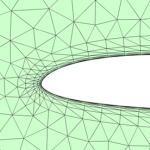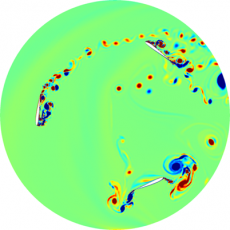High-Order Methods for Fluid-Structure Interaction with Applications to Vertical Axis Wind Turbine Simulations
The Mathematics Group has developed new numerical schemes for high-order accurate simulations of fluids and solids. This has led to efficient solvers that scale well on the new generation of multi-core computer architectures. The research focuses on applying these methods to relevant applications, such as wind turbine simulations. The studies have been used to determine optimal operating conditions and to maximize the power outputs of vertical-axis wind turbines, or VAWTs.

Detail of a blade-tip of the computational high-order mesh, showing the stretched elements required to resolve the turbulent boundary layer.
In more detail, the Math Group has developed new numerical methods for solving the equations that arise from these physical problems. One recent example is the Line-DG method, which is a class of high-order schemes that are 1-2 orders of magnitude more efficient than current approaches. They also developed implicit-explicit time-stepping schemes for accurate fluid-structure simulation without coupled Jacobian matrices. And finally, they improved the parallel block-ILU(0) and multigrid preconditioners that are used in the solvers, which scale well up to thousands of CPU cores. Math researchers have implemented the methods in the 3DG software package, which is used by a number of research groups at UC Berkeley, LBNL, and MIT, for simulations in areas such as wind turbines, flapping flight, and aeroacoustics.
These techniques replace the traditional low-order techniques for a range of simulation tools. They provide reliable levels of accuracy for challenging problems, involving wave propagation, multiple scales, multiphysics, and nonlinear interactions.
About Berkeley Lab
Founded in 1931 on the belief that the biggest scientific challenges are best addressed by teams, Lawrence Berkeley National Laboratory and its scientists have been recognized with 16 Nobel Prizes. Today, Berkeley Lab researchers develop sustainable energy and environmental solutions, create useful new materials, advance the frontiers of computing, and probe the mysteries of life, matter, and the universe. Scientists from around the world rely on the Lab’s facilities for their own discovery science. Berkeley Lab is a multiprogram national laboratory, managed by the University of California for the U.S. Department of Energy’s Office of Science.
DOE’s Office of Science is the single largest supporter of basic research in the physical sciences in the United States, and is working to address some of the most pressing challenges of our time. For more information, please visit energy.gov/science.










